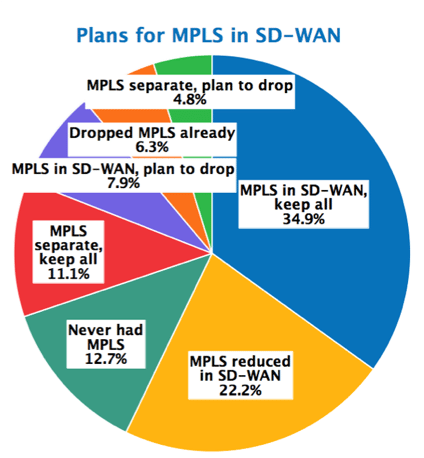|
Listen to post:
Getting your Trinity Audio player ready...
|
One of the big selling points of SD-WAN tools is their ability to use the Internet to deliver private-WAN levels of performance and reliability. Give each site connections to two or three Internet providers and you can run even demanding, performance-sensitive applications with confidence. Hence the amount of MPLS going away in the wake of SD-WAN deployments. (See Figure 1.)

The typical use case here, though, is the one where the Internet can also do best: networks contained within a specific country. In such a network, inter-carrier connectivity will be optimal, paths will be many, and overall reliability quite high. Packet loss will be low, latency low, and though still variable, the variability will tend to be across a relatively narrow range.
Global Distance = Latency, Loss, and Variability
Narrow relative to what? In this case, narrow when compared to the range of variation on latency across global networks. Base latency increases with distance, inevitably of course, but the speed of light does not tell the whole story. The longer the distances involved, the greater the number of optical/electronic conversions, bumping up latency even further as well as steadily increasing cumulative error rates. And, the more numerous the carrier interconnects crossed, the worse: even more packets lost, more errors, and another place where variability in latency creeps in.
A truly global Internet-based WAN will face innumerable challenges to delivering consistent high-speed performance thanks to all this complexity. In such a use case, the unpredictability of variation in latency as well as the greater range for the variation is likely to make the user experiences unpleasantly unreliable, especially for demanding and performance-sensitive applications.
Global Fix: Optimized Middle Miles
To fix the problem without simply reverting to a private WAN, one can seek to limit the use of public networks to the role they best fill: the ingress and egress, connecting a site to the world. But instead of having the Internet be the only path available to packets, you can also have a controlled, optimized, and consistent middle-mile network. Sites connect over the Internet to a point of presence (POP) that is “close” for Internet values of the term—just a few milliseconds away, basically, without too many hops. The POPs are interconnected with private links that bypass the complexity and unpredictability of the global Internet to deliver consistent and reliable performance across the bulk of the distance. Of course, they still also have the Internet available as backup connectivity! Given such a middle-mile optimization, even a globe-spanning SD-WAN can expect to deliver solid performance comparable to—but still at a lower cost than—a traditional private MPLS WAN.










